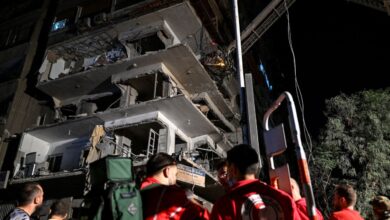Amman — Government forces backed by snipers on rooftops tightened their grip on Syria's third city on Monday, rights groups said, after President Bashar al-Assad sent in tanks in a sharpening crackdown on protests against his rule.
A human rights campaigner in Homs said snipers deployed in several residential neighborhoods as the sound of gunfire died down in districts of the city that tanks stormed on Sunday.
"There are snipers visible on rooftops of private and public building in al-Adawiya, Bab Sebaa and al-Mreijah neighborhoods. Hundreds have fled from three villages just to the southwest of Homs where tanks had deployed," the campaigner said.
Homs, the hometown of Assad's Western-educated wife Asma, lies in the middle of an agricultural region on the highway between Damascus and Syria's second largest city Aleppo. One of Syria's two oil refineries is in Homs.
The Syrian Observatory for Human Rights said three civilians were killed on Sunday in Homs, a merchant city of one million people 165 km (100 miles) north of Damascus.
Activists said the authorities had widened a shutdown of Internet and phone services.
Syrian authorities have banned foreign media from reporting from the country.
Security forces dispersed a small pro-democracy demonstration in the center of the Damascus on Monday, arresting opposition writer Ammar Mashour Dayoub and several students, the Syrian Observatory for Human Rights said.
In the capital's district of Barzeh, 20 people were arrested in another demonstration, a resident of Barzeh said.
In the south, tanks deployed around the towns of Inkhil, Dael and Nawa, widening a sweep into the strategic region that borders Jordan and the Israeli-occupied Golan Heights. A man was killed on Sunday when security forces smashed their way into his home in the town of Tafas, a rights campaigner said.
REGIME BASE
Syria's upheaval began on 18 March when protesters, inspired by revolts across the Arab World, marched in the southern city of Deraa. Assad initially responded with vague promises of reform, and last month lifted a 48-year-old state of emergency.
But when the demonstrations persisted he sent the army to crush dissent, first in Deraa and then in other cities, making clear he would not risk losing the tight control his family has held over Syria for the past 41 years.
Assad is from the minority Alawite sect, an offshoot of Shia Islam, while the majority of Syria's 20 million population is Sunni Muslim.
Alawites dominate Syria's power structure.
Hundreds of people were arrested on Monday in Homs and in Banias on the Mediterranean coast, the latest focus of Assad's escalating military swoop on protesters, as well as in other regions, the Observatory said.
A human rights campaigner said Military Intelligence agents arrested five employees at a state-owned wheat milling company in the mostly Ismaili city of Salamiya east of Hama for refusing to sign declarations promising not to demonstrate.
The Observatory said around 50 people were arrested in Salamiya on Monday, among them 70-year old former political prisoner Hassan Zahra, a leftist.
Syrian human rights organization Sawasiah said security forces have killed at least 800 civilians since demonstrations first broke out. The Syrian Observatory says 634 civilians had died by 30 April.
A Western diplomat last week estimated that around 7000 people had been detained.
Before the uprising, Assad had been emerging from a period of Western isolation imposed because of Syria's support for militant groups Hezbollah and Hamas and its informal anti-Israel alliance with Iran.
Washington announced new sanctions against Syrian figures last month while the European Union last week agreed to impose asset freezes and travel restrictions against up to 14 Syrian officials it said were responsible for the violent repression.
Syrian authorities have blamed the nearly two months of protests on "armed terrorist groups" they say killed civilians and security personnel and are operating in Deraa, Banias, Homs and other parts of the country.




